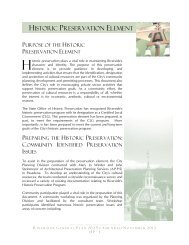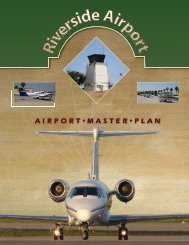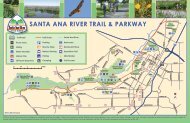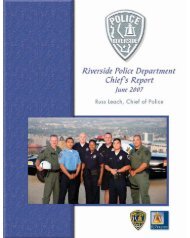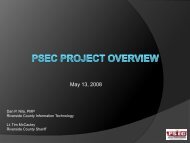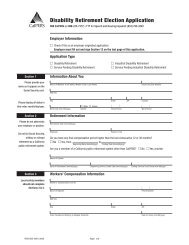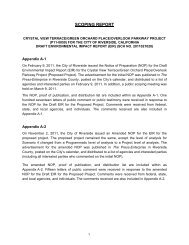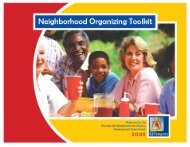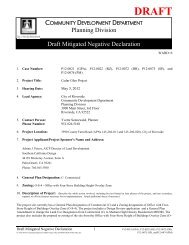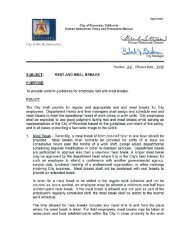Northside - City of Riverside
Northside - City of Riverside
Northside - City of Riverside
You also want an ePaper? Increase the reach of your titles
YUMPU automatically turns print PDFs into web optimized ePapers that Google loves.
during Phase II.<br />
This era is part <strong>of</strong> the Eclectic Period (circa 1880-1940) during which American<br />
architects drew on the broad collection <strong>of</strong> architectural tradition for stylistic<br />
inspiration, producing revivals <strong>of</strong> American, English, French, and Mediterranean<br />
period homes. Architectural interpretations <strong>of</strong> European designs were generally<br />
pure, yet the movement toward European period styles was diverse by nature.<br />
Generally, the early reign <strong>of</strong> the Eclectic Movement was curtailed by the rise <strong>of</strong> the<br />
Prairie and Craftsman styles yet revived by World War I, causing period revival<br />
architecture to be most prevalent in the 1920s and 1930s (McAlester 2000:319).<br />
Similarly, previous study in <strong>Riverside</strong> has characterized this period <strong>of</strong> development<br />
as a time when interest in diversification in response to the catastrophic 1913 freeze<br />
and the effects <strong>of</strong> World War I prompted <strong>Riverside</strong>’s residential, civic, and<br />
commercial architecture to become less locally distinct and more closely mirror the<br />
styles found across the country.<br />
Residential design within the <strong>Northside</strong>, however, did not seem to conform to this<br />
accepted view <strong>of</strong> architectural design trends in the 1920s and 1930s. Though strongly<br />
represented in the previous period, Craftsman examples persist into the 1920s,<br />
dominating the residential landscape <strong>of</strong> the survey area despite the popularity <strong>of</strong><br />
period revival designs seen one after another in other <strong>Riverside</strong> neighborhoods like<br />
Palm Heights to the south. Spanish Colonial Revival, Tudor Revival, Pueblo Revival,<br />
Colonial Revival, and Classical Revival designs are represented here, though in<br />
surprisingly small numbers perhaps revealing the influence <strong>of</strong> preceding,<br />
neighboring designs on new construction.<br />
Making up for the deficit in period revival styles in the survey area, however, are<br />
the high-styled, large homes that make up the North Hill Historic District in<br />
Fairmount Heights. Here the <strong>Northside</strong> boasts 12 grand, mostly architect-designed<br />
homes in the Spanish Colonial Revival, Tudor Revival, Monterey Revival, Pueblo<br />
Revival, and French Eclectic styles, and one in the Minimal Traditional style, the<br />
earliest modern style to emerge from the Eclectic Period. Also, pre-WWII vernacular<br />
examples exist throughout the survey area.<br />
Craftsman<br />
See Residential Architecture 1870-1900 and 1901-1918.<br />
Spanish Colonial Revival<br />
Initially spawned by the popularity <strong>of</strong> the Mission style, following the 1915 Panama-<br />
California Exposition, held in San Diego, California, the Spanish Colonial Revival<br />
style was redefined by the entire history <strong>of</strong> Spanish architecture. Buildings in the<br />
112



